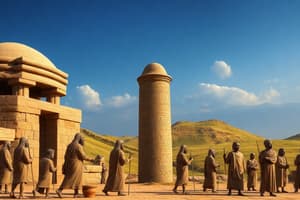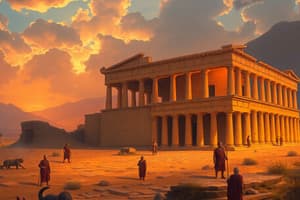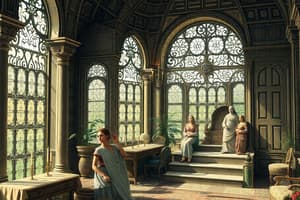Podcast
Questions and Answers
Which technological development was most crucial in enabling early humans to transition from a nomadic hunter-gatherer lifestyle to settled agricultural communities?
Which technological development was most crucial in enabling early humans to transition from a nomadic hunter-gatherer lifestyle to settled agricultural communities?
- The invention of the wheel for more efficient transportation.
- The development of irrigation systems for crop cultivation. (correct)
- The creation of metal tools for hunting larger game.
- The mastery of fire for cooking and protection.
What was a significant consequence of the surplus food production that resulted from the Neolithic Revolution?
What was a significant consequence of the surplus food production that resulted from the Neolithic Revolution?
- A decline in population due to poor nutrition.
- The disappearance of hunter-gatherer societies.
- An increased reliance on nomadic lifestyles.
- The development of specialized labor and social hierarchies. (correct)
How did the Code of Hammurabi contribute to the development of legal systems in ancient civilizations?
How did the Code of Hammurabi contribute to the development of legal systems in ancient civilizations?
- By establishing the concept of separation of powers.
- By introducing the idea of innocent until proven guilty.
- By advocating for equality and social justice for all citizens.
- By codifying laws and punishments, making them more consistent and predictable. (correct)
What was a major difference between the political structures of ancient Greece and the Roman Empire?
What was a major difference between the political structures of ancient Greece and the Roman Empire?
How did the fall of the Western Roman Empire impact Europe?
How did the fall of the Western Roman Empire impact Europe?
What was the primary goal of the Crusades?
What was the primary goal of the Crusades?
In what way did the Islamic Golden Age contribute to the preservation of classical knowledge?
In what way did the Islamic Golden Age contribute to the preservation of classical knowledge?
Which of the following factors motivated European powers to begin exploring new trade routes to Asia in the 15th century?
Which of the following factors motivated European powers to begin exploring new trade routes to Asia in the 15th century?
What was a significant consequence of the Columbian Exchange?
What was a significant consequence of the Columbian Exchange?
How did Martin Luther's Ninety-Five Theses challenge the authority of the Catholic Church?
How did Martin Luther's Ninety-Five Theses challenge the authority of the Catholic Church?
What was the main principle established by the Peace of Westphalia (1648)?
What was the main principle established by the Peace of Westphalia (1648)?
How did Enlightenment thinkers influence the American and French Revolutions?
How did Enlightenment thinkers influence the American and French Revolutions?
Which of the following was a major consequence of the French Revolution?
Which of the following was a major consequence of the French Revolution?
What was a key factor that enabled the Industrial Revolution to begin in Britain?
What was a key factor that enabled the Industrial Revolution to begin in Britain?
What motivated European powers to engage in imperialism in the 19th and early 20th centuries?
What motivated European powers to engage in imperialism in the 19th and early 20th centuries?
What event triggered the start of World War I?
What event triggered the start of World War I?
What was a major consequence of the Treaty of Versailles after World War I?
What was a major consequence of the Treaty of Versailles after World War I?
Which of the following factors contributed to the outbreak of World War II?
Which of the following factors contributed to the outbreak of World War II?
What was the primary focus of conflict during the Cold War?
What was the primary focus of conflict during the Cold War?
What are the major characteristics that define the Post-Cold War Era?
What are the major characteristics that define the Post-Cold War Era?
Flashcards
World History
World History
Study of past events, people, societies, and civilizations on a global scale.
Prehistoric Period
Prehistoric Period
Period from human emergence to the invention of writing, divided into Paleolithic, Mesolithic, and Neolithic.
Neolithic Revolution
Neolithic Revolution
Development of agriculture leading to settled communities and surplus food.
Ancient Civilizations
Ancient Civilizations
Signup and view all the flashcards
Sumerians
Sumerians
Signup and view all the flashcards
Code of Hammurabi
Code of Hammurabi
Signup and view all the flashcards
Ancient Egypt
Ancient Egypt
Signup and view all the flashcards
Indus Valley Civilization
Indus Valley Civilization
Signup and view all the flashcards
Ancient Greece
Ancient Greece
Signup and view all the flashcards
The Roman Empire
The Roman Empire
Signup and view all the flashcards
The Middle Ages
The Middle Ages
Signup and view all the flashcards
Feudalism
Feudalism
Signup and view all the flashcards
The Crusades
The Crusades
Signup and view all the flashcards
The Renaissance
The Renaissance
Signup and view all the flashcards
Age of Exploration
Age of Exploration
Signup and view all the flashcards
Columbian Exchange
Columbian Exchange
Signup and view all the flashcards
The Reformation
The Reformation
Signup and view all the flashcards
The Enlightenment
The Enlightenment
Signup and view all the flashcards
Industrial Revolution
Industrial Revolution
Signup and view all the flashcards
World War I
World War I
Signup and view all the flashcards
Study Notes
No new information was provided, the text provided is identical to the existing notes. No changes made.
Studying That Suits You
Use AI to generate personalized quizzes and flashcards to suit your learning preferences.




